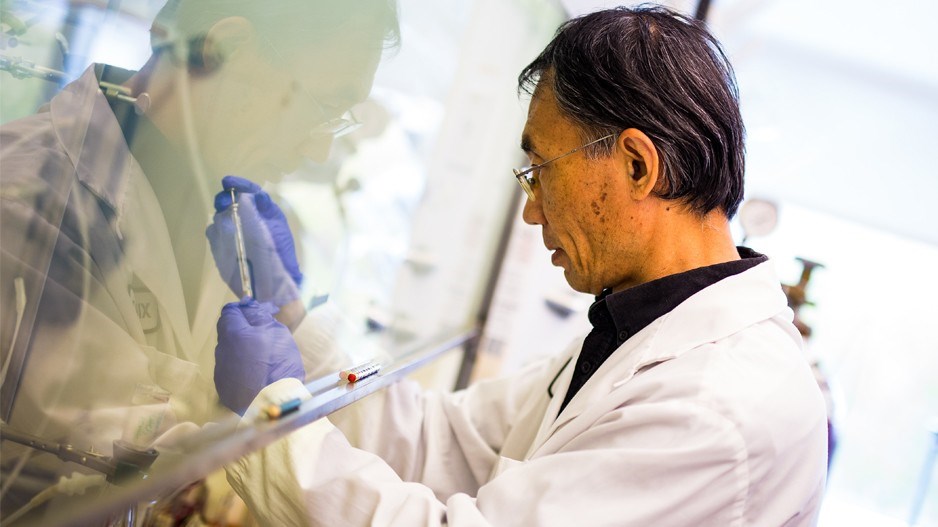“It's amazing,” says Pieter Cullis.
“Sometimes you wake up literally overnight and say this can’t actually be happening.”
The nanomedicine researcher has been plying his trade at the University of British Columbia since the 1970s, advancing the field nanoparticle technology to help treat thousands of people worldwide suffering medical ailments.
But with the COVID-19 pandemic, the co-founder of UBC spinoff Acuitas Therapeutics Inc. now sees his life’s work being deployed at a scale he never imagined.
Every shot of the Pfizer Inc. (NYSE:PFE) and BioNTech SE (Nasdaq:BNTX) messenger RNA vaccine — the most widely used one in Canada — is dependent on the lipid nanoparticle technology (LNP) developed by Cullis and his team.
Pfizer’s mRNA vaccine provides instructions to the cells in the body to make a protein on the surface of the COVID-19 virus. When the body produces that protein, the immune system recognizes it as being foreign and produces a response against it.
The problem is that mRNA is easily broken down by the body and cannot enter cells without help.
Enter Acuitas’ LNP technology, which essentially acts as a delivery vehicle for the mRNA to travel through the human body and enter the cells unharmed.
Many vaccine skeptics have been taking aim at the speed at which the vaccines were developed. However, the building blocks behind these vaccines have been in the works for decades.
When Cullis’ UBC lab launched in 1978, the focus was on delivering anti-cancer drugs into the human body with more precision and “having less of them [delivered] to sites that might be vulnerable to the toxic side effects,” he said.
After 15 years, the team decided to have a go at delivering much larger particles.
“To give you an idea of the scale, the molecular weight of the common anti-cancer drug would be around about 500 and then the molecular weight of a piece of RNA that we first started to work with was 13,000,” Cullis said.
Advances in LNP technology saw it later being tapped by a pharmaceuticals company focused on gene therapy to treat transthyretin-induced amyloidosis, a rare disease that results in the build-up of proteins in the body’s tissue and organs.
“We got the results back in 2017. They were absolutely brilliant and the drug was approved by the FDA [U.S. Food and Drug Administration],” Cullis said.
“Fifty-thousand people worldwide suffer from this, so it was a major triumph at that point and really validated the lipid nanoparticle approach.”
After that success, an immunologist from the University of Pennsylvania approached Acuitas about applying the LNP technology for use in a vaccine.
“So we said fine and packaged up some of his messenger RNA that was coding for proteins and things like Zika virus or influenza virus. And the results that he got from those studies were absolutely spectacular,” Cullis recalled.
That’s when Acuitas began working with Germany’s BioNTech on cancer vaccines.
“This was again progressing well but in January of last year — of 2020 — of course the pandemic hit,” Cullis said.
“BioNTech had been working with Pfizer on an influenza vaccine and so everybody decided that, ‘OK, we better change our track here.’”
In less than five years, Acuitas’ LNP technology had gone from being deployed to help treat 50,000 people to being integral in vaccinating billions worldwide against COVID-19.
“They're a great story of how an ecosystem works,” said Wendy Hurlburt, CEO of LifeSciences BC, whose industry association advocates on behalf of local biotech firms.
“COVID hit, they pivoted very quickly, used their technology to work on a COVID vaccine and then in swoops Pfizer that has scale. And it's a great example of how an ecosystem works well with all players collaborating and bringing their respective strengths to the table.”
Acuitas CEO Thomas Madden said the recent success with the mRNA vaccine has proven how well a biotech can thrive in Vancouver.
“It shows how academic roots can be translated very successfully to commercial and technical success. At the same time, I think we have to realize that Vancouver is not a biotechnology hub. We lack some of the other components that really foster the entrepreneurial development here,” he told BIV last fall.
Among those components is access to venture capital for startups.
A May 6 report commissioned by the Greater Vancouver Board of Trade noted the province’s biotech sector has been exceptionally active the past year with a record-breaking US$1.58 billion raised on the capital markets.
But all those companies on the receiving end of that capital are all beyond the startup stage.
The report recommends the adoption of a six policy changes to advance growth within the sector:
· More investment in attracting talent
· The creation of a dedicated life sciences fund
· Streamlined regulatory and tax policies more aligned to global standards
· Better procurement strategies
· Better access to data
· Further investments in lab and manufacturing infrastructure
Meanwhile, Cullis said the amazing thing is how well the LNP technology been applied to different uses.
“It’s really taken the nanoparticle technology from being something that was not really on everybody's mind — let's put it that way — to being something that's mainstream now in therapeutics.”
—With a file from Chuck Chiang




